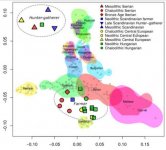Goga
Banned
- Messages
- 2,651
- Reaction score
- 152
- Points
- 0
- Y-DNA haplogroup
- R1a*
- mtDNA haplogroup
- HV1b2
Thanks for sharing info about this Shulaveri-Shomu culture. Somehow I was not really interested in this culture. But I'm going to try to 'update' my knowledge abut it.Guys, Guys (and girl)...
Kumtepe6 woman (4800bc) is Shulaveri-Shomu (kicked out from Kotias land 4900bc) with H2 mtdna and always found a bit awkward by decoders because it shifted too much to CHG for a late neolithic in western anatolia. Also that woman shared ancestry with a 1000bc F38 a R1b1a2a2-CTS1078/Z2103 just north of lake Urmia…so Caucasus as well anyways. Actually just near the other R1b (although X L23) from 4000bc.
Just need to sample a bit more. Those kuban river settlements opening the gates to steppe land, arising at the same time (4800bc) as Kumtepe are also the same Anatolia_N loaded up with CHG from kotias land. Probably why Joahanne Krause now makes a map with that migration by 4900 bc. By around 4500bc they were as far away as Samara. Remember… cereals from south Caucasus totally fail I north Caucasus. So, keep on running.
I just figure it out when I read about Kumtepe I(a) (so Kum6) so the founders of Kumtepe and saw the assemblage… oh yes. My shulaveri.
http://www.ascsa.edu.gr/pdf/uploads/hesperia/147895.pdf
Large amount of people kicked out… they had to show up somewhere…
Yamnaya and steppe… my a*s.
That's why I said that I 'never heard of pre-Yamnaya migration from the Steppes into the Balkans'..





